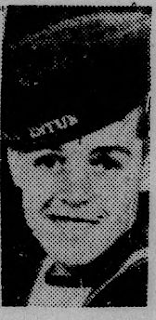Ilbert Parsons
 |
| Ilbert Parsons |
 |
| South Wales Daily Post |
H.M.S. Bonaventure
was the flagship of the Dido-class
light cruisers built for the Royal Navy during the 1930s and WWII. Completed in
1940, it joined the Home Fleet and took part in Operation Fish,
evacuating British assets to Canada in July. Operation Fish was the
largest movement of physical wealth in history, transferring British money and
gold ingots to Canada for safekeeping during World War II.
 |
| H.M.S. Bonaventure |
Following the sinking of H.M.S. Bonaventure, Ilbert served
with H.M.S. Gloucester, ranked Boy 1st Class.
 |
| H.M.S. Gloucester |
H.M.S. Gloucester
bombarded Libya in April, then covered a convoy to Malta. On the night of April
20th-21st, it joined battleships Warspite, Valiant, Barham, and destroyers to attack Tripoli
harbour successfully. At month's end, it briefly transferred to Force H at
Gibraltar before escorting a convoy to Malta and rejoining the Mediterranean
Fleet for Operation Tiger in early May.
At 12:25, Force A1, positioned 20 to 30 miles west of
Antikythera, received a request from Rear Admiral Edward Leigh Stuart King to
provide support for the damaged Naiad
and the remainder of his Force C. Consequently, Force A1 proceeded east into
the Kythira Strait, rendezvousing with Force C between 13:30 and 14:00. As the
senior admiral, King assumed command, despite both forces sustaining damage
from air attacks. At 14:02 and 14:07 respectively, Fiji and Gloucester were
dispatched to deliver anti-aircraft assistance to the destroyers Kandahar and Kingston. These destroyers had already been tasked with rescuing
survivors from the destroyer Greyhound,
which had been sunk at 13:50. In his post-battle dispatches, Cunningham noted
that King was unaware of the anti-aircraft ammunition shortages in Fiji and Gloucester. At 14:13, King and Rawlings exchanged communications
regarding the ammunition shortages within both Force C and Force A1, with
Rawlings voicing concerns about the orders given to Gloucester and Fiji.
Following this exchange, King issued an order at 14:57 to recall both Gloucester and Fiji.
While navigating the Kythira Strait, approximately 14 miles
north of Crete, H.M.S. Gloucester and
H.M.S. Fiji came under attack by
Stukas from StG 2. Between 15:30 and 15:50, during an attempt to rejoin Force
A1, H.M.S. Gloucester was struck by
several bombs, prompting a decision to abandon her due to the intensity of the
air assaults. Despite being under heavy fire, H.M.S. Fiji deployed rafts for H.M.S. Gloucester
as she passed, but could not halt, leading to her sinking within a few hours. 807
men aboard at the time of her sinking, only 85 survived
 |
| Ilbert Parsons Plymouth Naval Memorial credit - findagrave |


Comments
Post a Comment